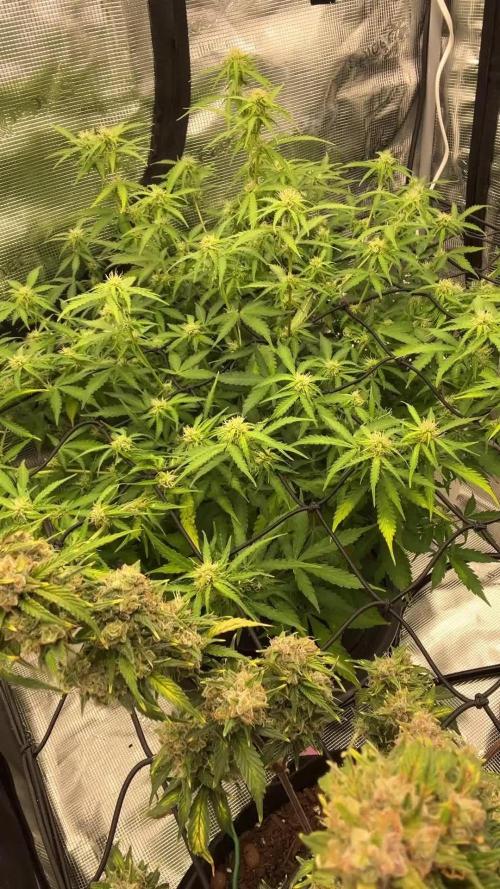The Grow Awards 2026 🏆 





































Likes
Comments
Share


@BOMbolenath
Follow
First week of flowering. The plant will stretch, so i adjusted the LED dimmer to 100%. Did a good defoliation too. Doing good, very healthy big plant. It grew a lot of ramifications.
Likes
15
Share


@SaucePan
Follow
Stopped feeding last week.. this strain was loving the Humbolt flower stacker ..she’s got a few days left of flushing ... looking forward to harvest time.. it’s been fun and therapeutic since my bean popped on 4/21
Likes
45
Share


@Mosquito_Haarlem
Follow
Heerlijke harde volle toppen en voor het eerst dat ik harsdruppels zie.
Een heerlijke strain om te growen.
De plant wordt in zijn geheel opgehangen en ik zal het droge gewicht wegen.
Likes
2
Share


@MT_Farmer
Follow
Still only watering ph'd water. The plants are actually quite different, the one in the front seems to expand out towards the sides much more the the one in the back. Also the colors of teh leaves are different
Likes
1
Share


@MindFlowers68
Follow
A mostly uneventful week for the outdoor photoperiods. The were watered once with the cal-mag/kelp solution and were kind of pounded with rain most of the week.Then It got very humid too. I was worried for the plants during the storm we had they we calling for 70 mph winds that took down some powder lines and trees down the street. While i don't have the plants rigidly staked the cages were able to support the plants during the storm. Im not sure if the stakes would help or hurt i have a feeling it would help them snap easier rather than bend with the wind. They all survived and are getting some nice intense sunlight after the storm. I'm hoping I will be able to take some clones this week. Also hoping that my mantis cocoons will hatch!
Processing
Likes
10
Share


@CreoWeed
Follow
Here we are in what it will be the final week... I am now at day 61 and I'm considering to cut at the end of this current week... in 2 days basically...
I recently bought a scope that allows me to check the trichomes and I can see all milky ones, I also posted some videos of it, please guys let me know your thoughts...
Beside this buds are hard like rocks and smell still pretty intense and I cannot wait to taste this short but bulky phenotype.
I'll keep you guys posted if I harvest or not this week hoping to read some of your comments.
So Stay tuned, stay high!
- - - - - - - - - - - - - -
Little update at Day 63.
I decided to give her few more days, so next week will be chopping her, this mostly cause I watered her last time on Day 61 and now I am basically just waiting for the soil to be dry.
I count to put her in the dark for 48 hours at Day 65 and finally chop her at day 67, I cannot wait to update you for the harvesting part.
I expect to reach 50/60 grams dry and I really hope to achieve that.
Keep you guys posted! Stay tuned, stay high!
Likes
77
Share


@cheetah844
Follow
Still waiting for trichomes to amber up⏳
This is a very enjoyable grow using LST. Much more time consuming but I enjoy gardening so it's great for me.
I'm excited to see harvest amounts with LST💚🤗
I've moved both Gelato & Younger Zkittlez into a colder dimly lit room to hopefully enrich their colors. I will be harvesting them in the next day or two.
I've moved the two remaining mother plants into the smaller grow tent to finish flowering & I moved the clones to the larger grow space finally!
Likes
29
Share


@Spliffing_Around
Follow
Big mistake I made with lightning , which made this strain suffer a lot. Inderlit buds lead to larf, will reduce that next time. I didn’t really weight it, it’s going for hash, but left at least 100g as flower.
Likes
14
Share


@CampaCavallo
Follow
7ª Settimana di Fioritura 💐💐💐💐💐💐💐
Ma quanto sta diventando bella la nostra RUNTZ 💓😍?
Come si stanno gonfiando i suoi bei cimoni innevati🏔️💓
Processing
Likes
7
Share


@gablmo
Follow
It was a busy week full of events. I got them a 600 watts HPS light and microbes to help them grow faster. I finally started the trellis netting to even the canopy and get more from the lights and I also spray the plants again for bugs. I found out that I've been using powder nutrients on my reservoir and that's probably why I've been getting floods two or tree times a week and now the valve is open only when I'm there, because I'm sick of cleaning and I took that little sick plant out. My cats have her now.
Likes
7
Share


@Young_agronomist
Follow
1️⃣18.08.23- 49 дней от каски и третья неделя цвета. Все стабильно , полет нормальный , шишки растут .
Добавил booster bloom .
2️⃣22.08.23- Рост прекратился и сфокусировался на увеличении почек .
Был проведен flash clean и изменен ппм в сторону меньшей концентрации .
Так как этот сорт не любит большого количества удобрений
Likes
58
Share


@Papablob
Follow
12/09 Ca y est, elle montre les premiers , vrai, signes de senescence. Impec , comme je part 18 jours, elle sera prête a couper à mon retour. 😁👍
Likes
10
Share


@Diegobike
Follow
He estado de viaje hoy vuelvo y veo mi niña ya empezando floración como dios manda esperemos que está mamba salga re bombastic
Likes
15
Share


@YOZYY
Follow
Middle front was not doing so great but once I feed it some Calimagic and a heavier dose of nutrients it fixed itself just was hungry. Just gonna let them do their stretching till week 2 or 3 then I'm gonna raise the light watts.
Likes
5
Share


@BigLamar
Follow
Week 1 now complete since we flipped the switch.
Pistols are are creeping out slowly but surely.
Decent.
See what happens….
Processing
Likes
41
Share


@FrostyGardens
Follow
11/03/18
Everything is going well. No issues at all. Plucking a leaf here n there but no real defoilation. Between the Black Magic Soil, and AACT this run has been smooth sailing no deficiencies or leaf damage at all. Humidity still cranked up to make up for the lack of humidity in veg. Will reduce over the next few weeks.
11/05/18
Decided to defoilate today. The plants always look sad to me and I feel bad. They always recover though and come back better then ever!
Likes
6
Share


@Kendoda
Follow
I’ll be reducing each nutrient by 0.5ml from last weeks total, as there’s nute burn on most leaf Tips.
The funky aroma coming from this girl this evening is just amazing, her layers are sweet and gassy. There’s almost like a sickly rubber smell to her . She’s got it going on. Wow!
Likes
18
Share


@Stonyways
Follow
relaxing and enjoying the show
almost at max watts
SPIDER FARMER SF2000 is now maxed out at 207w , 16"-18" from the plants and I will need to keep up with pruning to allow more air flow and more light to penetrate deeper into the plant.
2, 6" oscillating fans on 100%, may be on low or just one stationary but at this point in the grow air flow is a MUST, specially for the thick, dense vegetation of the OG Kush.
trying my hardest to stick with the 4" ventalation til the end of the grow. Right now I have to replace the exhaust ducting due to tiny pin holes leaking more than a bit of light.
Likes
1
Share


@HuskyHouse
Follow
Her roots started coming out of the pot and was going into the gravity fed system about 5-6 days ago, trimmed her roots with a scissors slightly and elevated the pot for a few hours to air prune and is showing no signs of stress! Did a feeding today, I will be giving her 2 feeding a week for a few weeks during the beginning of flowering.
















